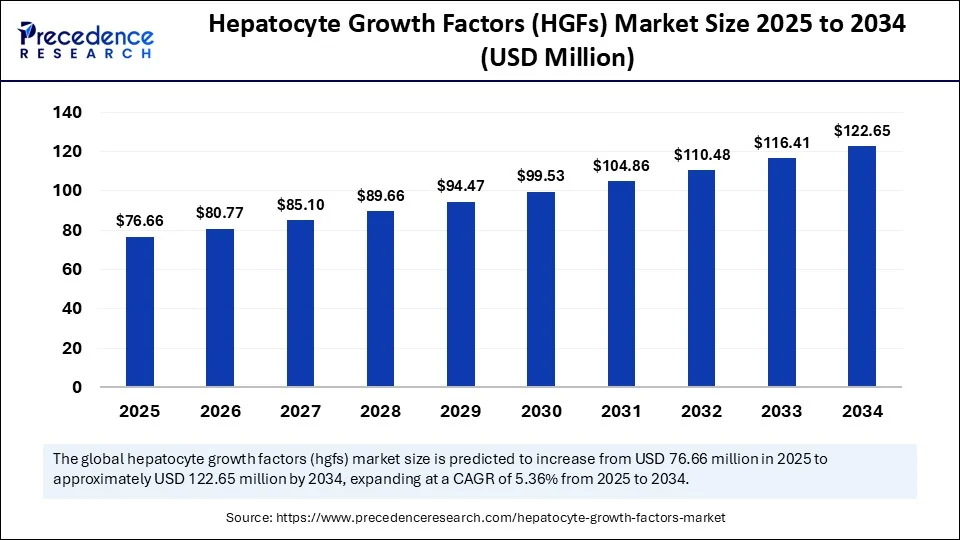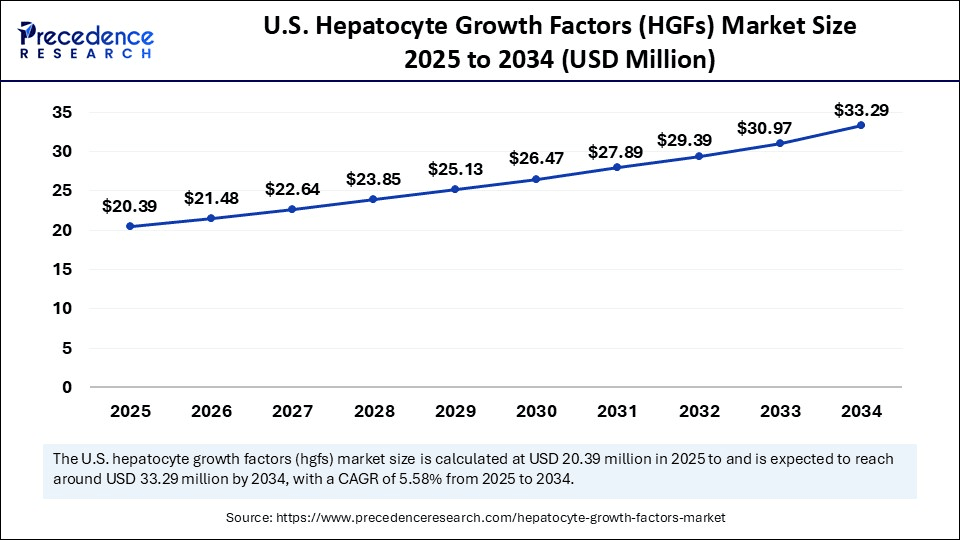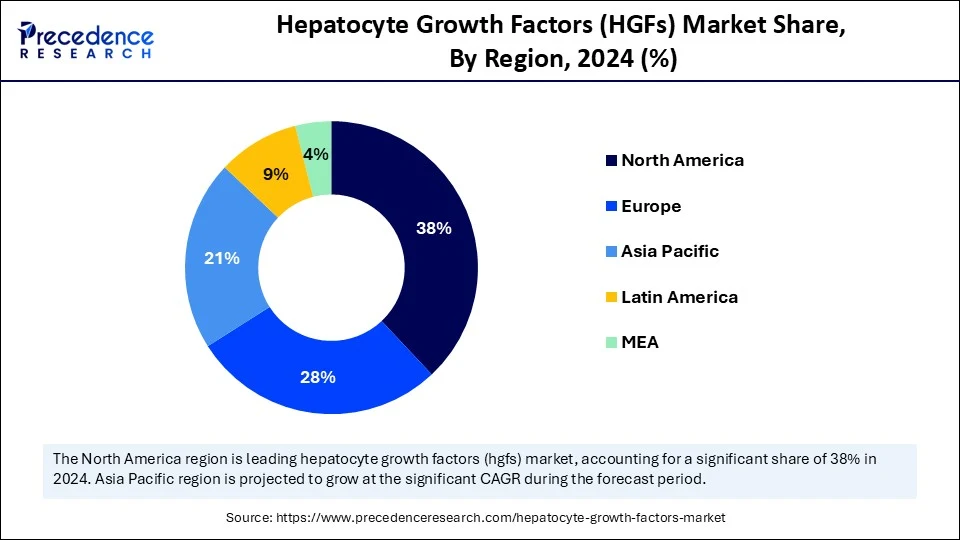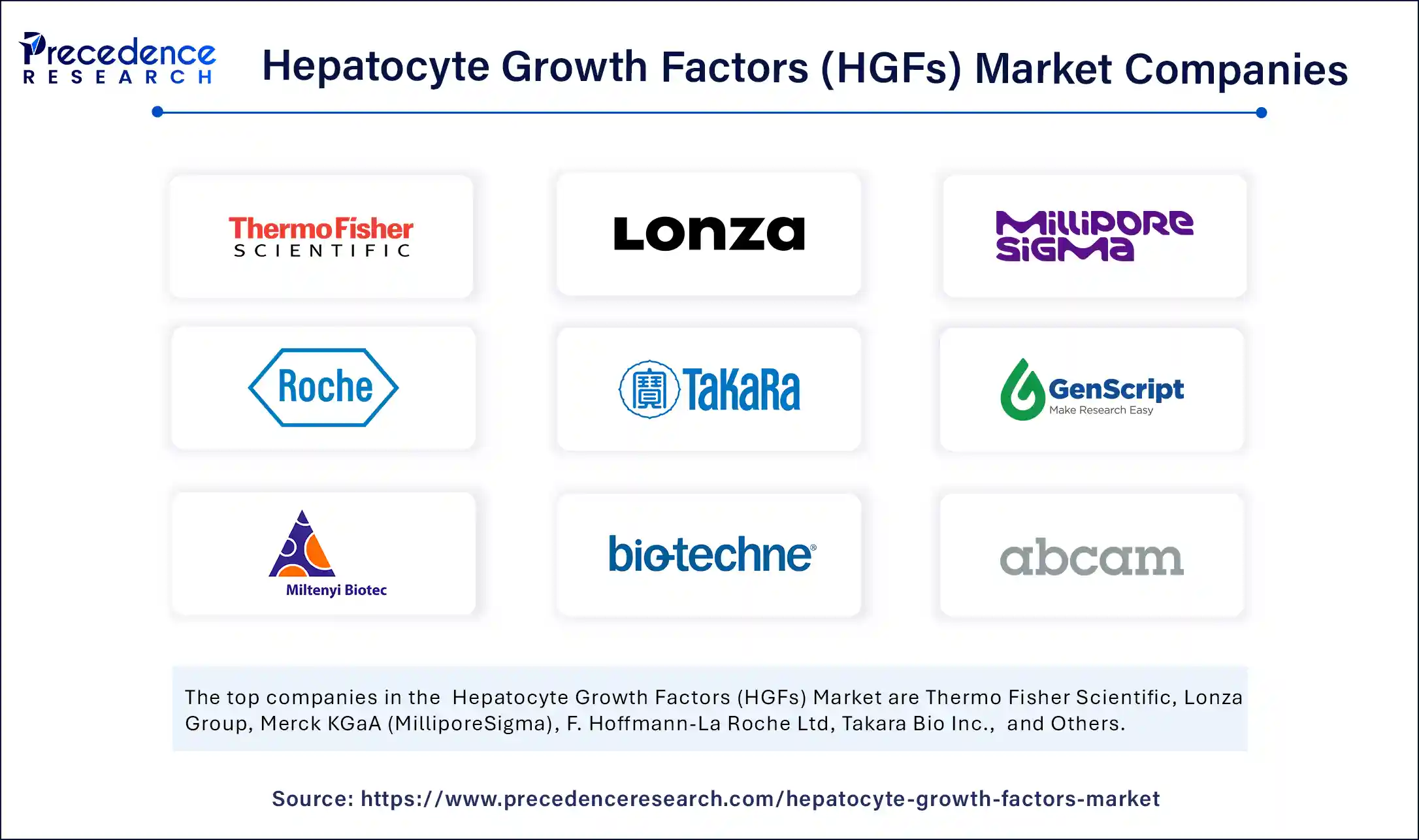List of Contents
Hepatocyte Growth Factors (HGFs) Market Size and Forecast 2025 to 2034
The global hepatocyte growth factors (HGFs) market size was estimated at USD 72.76 million in 2024 and is predicted to increase from USD 76.66 million in 2025 to approximately USD 122.65 million by 2034, expanding at a CAGR of 5.36% from 2025 to 2034. The market is experiencing significant growth due to the rising incidence of liver disorders and increased research into regenerative medicine. Advancements in cell-based therapies, which show promise for tissue repair and organ regeneration, and growing clinical applications of HGFs for liver and kidney diseases are expected to drive market growth in the coming years.

Hepatocyte Growth Factors (HGFs) Market Key Takeaways
- In terms of revenue, the global hepatocyte growth factors (HGFs) market was valued at USD 72.76 million in 2024.
- It is projected to reach USD 122.65 million by 2034.
- The market is expected to grow at a CAGR of 5.36% from 2025 to 2034.
- North America dominated the hepatocyte growth factors (HGFs) market with the largest share of 38% in 2024.
- Asia Pacific is expected to grow at the fastest CAGR from 2025 to 2034.
- By product type, the recombinant hepatocyte growth factors segment captured the biggest market share of 42% in 2024.
- By product type, the HGF gene therapy products segment is expected to grow at a significant CAGR over the projected period.
- By application, the regenerative medicine segment contributed the highest market share of 35% in 2024.
- By application, the oncology segment is expected to grow at a significant CAGR from 2025 to 2034.
- By end user, the pharmaceutical & biotechnology companies segment held the biggest market share of 40% in 2024.
- By end user, the CROs (contract research organizations) segment is expected to expand at a significant CAGR from 2025 to 2034.
- By delivery mechanism, the protein-based delivery segment generated the major market share of 47% in 2024.
- By delivery mechanism, the mRNA-based delivery segment is anticipated to grow at a significant CAGR from 2025 to 2034.
- By source, the human-derived segment held the largest market share of 38% in 2024.
- By source, the synthetic/engineered sources segment is projected to grow at the highest CAGR between 2025 and 2034.
How Can AI Impacts the Hepatocyte Growth Factors (HGFs) Market?
Artificial intelligence (AI) is transforming the market for hepatocyte growth factors (HGFs) by accelerating drug discovery and development and enabling the development of personalized medicine. AI algorithms analyze large datasets of genomic and proteomic information, speeding up the identification of new therapeutic targets for liver diseases and improving diagnosis and management, including hepatocellular carcinoma. Moreover, AI can optimize manufacturing processes of HGF products, enhance supply chain management, and help reduce costs. AI can also analyze patient data to determine the most effective doses and administration methods for HGFs, improving patient outcomes.
U.S. Hepatocyte Growth Factors (HGFs) Market Size and Growth 2025 to 2034
The U.S. hepatocyte growth factors (HGFs) market size was evaluated at USD 19.35 million in 2024 and is projected to be worth around USD 33.29 million by 2034, growing at a CAGR of 5.58% from 2025 to 2034.

What Made North America the Dominant Region in the Hepatocyte Growth Factors (HGFs) Market in 2024?
North America dominated the hepatocyte growth factor (HGF) market while capturing the largest share in 2024, due to its advanced biotech industry and supportive regulatory environment. Growing awareness of HGF's potential benefits, combined with an aging population and increasing chronic disease prevalence, has driven the demand for HGFs. The region's robust healthcare system, strong focus on R&D, and the presence of leading pharmaceutical and biotech companies have further propelled market growth. Favorable policies, including funding for biomedical research and streamlined regulatory processes, have played a vital role. The emphasis on research, clinical trials, and innovative therapies has fostered a favorable environment for HGF-based solutions.
U.S. Hepatocyte Growth Factors (HGFs) Market Trends
The U.S. is a major contributor to the market within North America, owing to its strong healthcare infrastructure, significant investment in HGF research by pharmaceutical companies, biotech firms, and academic institutions, as well as a focus on clinical trials and new therapies. The high incidence of liver diseases like cirrhosis and hepatocellular carcinoma further drives demand for HGF-based treatments and research, making the U.S. a key driver in developing and applying HGFs in regenerative medicine. Rising development of novel therapeutics further supports market growth.

What Makes Asia Pacific the Fastest-Growing Region in the Hepatocyte Growth Factors (HGFs) Market?
Asia Pacific is experiencing the fastest growth, driven by rising rates of chronic diseases, expanding healthcare infrastructure, and increased healthcare spending. Governments of various Asian countries actively promote pharmaceutical development and research through funding, regulatory streamlining, and incentives for clinical trials. Clinical trials in this region tend to be less costly than those in Western countries, attracting global pharmaceutical companies. With a large population base, the region provides access to many potential clinical trial participants.
India Hepatocyte Growth Factors (HGFs) Market Trends
India is emerging as an important player due to increasing research activities and improving healthcare access. The country faces a significant burden of liver disease, which boosts the demand for new therapies and diagnostics, including HGF-based kits. While the high cost of HGF ELISA kits currently limits market expansion, efforts to improve healthcare infrastructure and government support for biotech and regenerative medicine research are expected to expand the market.
Why is Europe Considered a Notable Region in the Hepatocyte Growth Factors (HGFs) Market?
Europe is a notable region in the market. The growth of the market in the region is attributed to a strong research and development base, increasing advancements in biotechnology, and supportive regulatory frameworks. Europe has a well-established biotechnology sector, investing heavily in research and development, leading to advancements in HGF-related technologies and applications. Several countries, such as Germany, the UK, France, and Italy, have advanced healthcare systems and infrastructure, which facilitate the adoption of new therapies and support research and development in HGFs. Furthermore, rising awareness of HGF's therapeutic potential, especially in regenerative medicine and treating chronic diseases, also contributes to this growth.
How Will Latin America Surge in the Hepatocyte Growth Factors (HGFs) Market?
Latin America is expected to experience significant growth in the upcoming period, driven by increasing disease prevalence, particularly liver, cardiovascular, and neurological conditions, and a growing geriatric population. Latin America is also facing a rising burden of various cancers, creating a higher demand for therapies utilizing HGFs. Latin American countries are investing more in healthcare infrastructure and access, which indirectly encourages the adoption of innovative therapies like HGFs. Although specific government initiatives directly targeting HGFs are not widely available, the region's overall focus on healthcare improvements and international collaborations is fostering a favorable environment for HGF market expansion.
What Factors Contribute to the Hepatocyte Growth Factors (HGFs) Market in the Middle East & Africa?
The market in the Middle East & Africa is expected to grow due to the increasing prevalence of chronic liver diseases, heightened investments in biotechnology research, and expanding healthcare infrastructure. Chronic liver conditions like hepatitis and cirrhosis are becoming more common in the MEA, increasing demand for effective treatments such as HGF-based therapies. The region is also experiencing growing investments in biotech research and development, particularly in regenerative medicine, which uses HGF for tissue repair and cellular regeneration. Several governments in MEA are implementing policies and initiatives to improve healthcare access, promote research, and support the development of innovative therapies like HGF-based treatments.
Market Overview
The hepatocyte growth factors (HGFs) market encompasses the global ecosystem of products, technologies, and services involved in the research, development, manufacturing, and application of hepatocyte growth factors. HGFs are a family of proteins vital for liver regeneration, embryonic development, tissue repair, angiogenesis, and tumor growth. They are mainly used in regenerative medicine, oncology, cell-based therapies, preclinical drug testing, and organ transplantation research. This market includes recombinant proteins, HGF gene therapies, and hepatocyte-based cell culture products across both therapeutic and research fields. The growth of this market is driven by an increasing number of surgical procedures, rising prevalence of chronic diseases, and growing interest in regenerative medicine.
What are the Key Trends in the Hepatocyte Growth Factors (HGFs) Market?
- Drug Discovery and Development: Hepatocyte Growth Factor (HGF) and its receptor, c-Met, are important targets for drug development in oncology, as HGF is involved in cancer cell growth and metastasis. Research on HGF's role in cancer has led to the creation of targeted therapies that modulate the HGF/c-Met signaling pathways.
- Tissue Regeneration and Wound Healing: HGFs are crucial for repairing damaged tissues, such as the skin, liver, and kidneys. This function is especially important in post-surgical wound care and the treatment of chronic wounds. The high volume of surgeries performed globally directly increases the demand for HGF-based therapies.
- Angiogenesis and Vascular Health: HGFs are known to promote angiogenesis, making them subjects of investigation for their potential to treat cardiovascular diseases and improve tissue perfusion. Research indicates that HGF can work synergistically with other growth factors, like Vascular Endothelial Growth Factor (VEGF), to enhance blood vessel growth.
- Increasing Research Funding and Investment: The growing investment and funding for research in biotechnology and pharmaceutical companies are driving advancements in HGF research and development, leading to new applications and contributing to market growth.
Market Scope
| Report Coverage | Details |
| Market Size by 2034 | USD 122.65 Million |
| Market Size in 2025 | USD 76.66 Million |
| Market Size in 2024 | USD 72.76 Million |
| Market Growth Rate from 2025 to 2034 | CAGR of 5.36% |
| Dominating Region | North America |
| Fastest Growing Region | Asia Pacific |
| Base Year | 2024 |
| Forecast Period | 2025 to 2034 |
| Segments Covered | Product Type, Application, End User, Delivery Mechanism, Source, and Region |
| Regions Covered | North America, Europe, Asia-Pacific, Latin America, and Middle East & Africa |
Market Dynamics
Drivers
Rising Incidence of Chronic Diseases and Advancements in Biotechnology
The primary driver of the hepatocyte growth factors (HGFs) market is the rising incidence of chronic diseases, such as liver illnesses, cardiovascular disorders, and various types of cancer. HGFs play a crucial role in liver and heart tissue generation, making them important components in treatments for liver and heart-related conditions. Advances in biotechnology, particularly in regenerative medicine, further drive market growth. Innovations in biotechnology, including genetic engineering, stem cell technology, and molecular biology, have accelerated the development of HGFs for clinical use. There is an increasing focus on producing recombinant HGFs and using gene therapy to enhance liver regeneration and treatment outcomes, propelling the growth of the market.
Restraint
High Cost Associated with Research and Development
The main challenge facing the hepatocyte growth factors (HGFs) market is the high cost associated with research and development, particularly in developing and delivering HGF-based therapies. This includes expenses related to preclinical and clinical trials, manufacturing, and ensuring the stability and delivery of HGF, which can be complex. Developing HGF-based treatments is costly due to the molecule's complexity, the need for specialized manufacturing processes, and the rigorous testing required for clinical approval. As a result, the high cost can limit accessibility and affordability, potentially impeding market growth.
Opportunity
Expanding Therapeutic Applications
A significant future opportunity in the hepatocyte growth factors (HGFs) market lies in exploring the potential of HGFs in new indications, particularly in oncology, kidney diseases, and wound healing. The development of novel HGF-based therapies for a broader range of conditions also opens up new growth avenues. Although HGF has been primarily studied for liver regeneration and wound healing, current research is exploring its potential in treating various cancers. HGF is involved in cancer cell growth, migration, and resistance to therapy, making it a target for cancer treatment. Additionally, research is examining HGF's role in neuroprotection and nerve regeneration, which could lead to therapies for stroke, Alzheimer's disease, and other neurological conditions.
Product Type Insights
What Made Recombinant Hepatocyte Growth Factors the Dominant Segment in the Market?
The recombinant hepatocyte growth factors segment dominated the hepatocyte growth factors (HGFs) market with the largest share in 2024. This is mainly because of their superior consistency, scalability, and purity when produced through recombinant methods, compared to natural or synthetic sources. This allows for more reliable and controlled therapeutic use. Recombinant HGFs are produced in controlled laboratory settings using genetically engineered cells, ensuring a consistent supply with predictable properties, unlike HGFs derived from natural sources like blood, which can vary in purity and concentration. Gene editing techniques such as CRISPR-Cas9 enable precise manipulation of HGF pathways, boosting their therapeutic potential and reducing side effects.
The HGF gene therapy products segment is expected to grow at the fastest rate in the upcoming period, primarily because of their potential for targeted and effective treatment, especially in regenerative medicine and oncology. Gene therapy enables direct delivery of HGF to specific cells or tissues, which can minimize side effects and increase therapeutic efficacy. Techniques like CRISPR-Cas9 allow exact gene modifications, leading to more effective HGF gene therapies. The positive results from Phase III clinical trials involving HGF gene therapy are boosting investor confidence and spurring further research and development.
Application Insights
How Does the Regenerative Medicine Segment Lead the Hepatocyte Growth Factors (HGFs) Market in 2024?
The regenerative medicine segment led the market in 2024. This is mainly due to HGFs' essential role in tissue regeneration and repair, particularly in liver diseases. The segment's dominance is also reinforced by the rising incidence of liver ailments and the capacity of HGFs to stimulate liver regeneration and cellular growth. Since HGFs play a central role in tissue regeneration and cell differentiation across various fields, including oncology, neurology, and wound healing, technological advances like CRISPR-Cas9 gene editing and recombinant protein engineering enable more precise manipulation of HGF pathways, improving their therapeutic potential in regenerative medicine.
The oncology segment is expected to expand at the fastest CAGR during the forecast period. The growth of the segment is attributed to HGF's significant involvement in cancer development, progression, and metastasis. HGF's interaction with the c-Met receptor is linked to several cancer features, such as cell proliferation, migration, and angiogenesis. The increasing prevalence of cancer, along with ongoing research into HGF's role across different cancer types, supports this growth. The numerous clinical trials investigating HGF and its inhibitors in cancers like liver and kidney cancers contribute to market expansion. Advances in biologic drugs, gene editing, and AI-powered drug discovery are further accelerating the development of HGF therapies, fueling growth in the oncology sector.
End User Insights
Why Did the Pharmaceutical & Biotechnology Companies Segment Dominate the Market in 2024?
The pharmaceutical & biotechnology companies segment dominated the hepatocyte growth factors (HGFs) market in 2024, owing to their vital role in drug development, regenerative medicine research, and clinical trials. These companies are at the forefront of leveraging HGFs for therapeutic use, including cancer treatment, liver disease management, and tissue regeneration. Their investments in research to identify and develop HGFs as potential therapeutic targets drive innovation and growth in the market for diseases. A large proportion of HGF-related clinical trials are sponsored and conducted by pharmaceutical and biotech companies, further solidifying their dominance in the market.
The CROs (contract research organizations) segment is likely to grow at the highest CAGR over the projection period. This is due to increased demand for specialized research services and the rising trend of outsourcing. This growth is driven by the rising prevalence of chronic diseases, the need for personalized medicine approaches, and the complexities of HGF research, which often require specialized expertise and resources. Outsourcing research to CROs can be more cost-effective for pharmaceutical and biotechnology companies than building and maintaining in-house capabilities, especially in niche areas like HGF research. The increasing complexity and sophistication of HGF research, including the need for advanced assays and detailed data analysis, also contribute to segmental growth.
Delivery Mechanism Insights
How Does the Protein-Based Delivery (Recombinant) Segment Dominate the Hepatocyte Growth Factors (HGFs) Market in 2024?
The protein-based delivery segment sustained dominance in the market in 2024, holding the largest share. The dominance of protein-based delivery mechanism stems from its high biocompatibility, controlled release capabilities, and targeted delivery potential. Proteins are naturally compatible with the body, minimizing adverse reactions. Protein-based delivery systems can be designed to release HGFs over extended periods, optimizing therapeutic effects. Additionally, proteins can be engineered for specific stimulus-responsiveness, allowing localized release in affected tissues. Proteins can also be engineered to minimize aggregation, a common issue with protein-based therapies.
The mRNA-based delivery segment is expected to experience rapid growth in the coming years, mainly because of its potential for targeted delivery, reduced risk of integration into the host genome, and efficient protein expression. Advances in LNP technology and other delivery methods enable targeted delivery of mRNA to specific cells or tissues, like hepatocytes, improving therapeutic efficacy and reducing side effects. Modified mRNA can also be engineered to be less immunogenic, lowering immune response risks and boosting therapeutic potential, allowing quicker responses to emerging health needs, such as COVID-19 vaccines.
Source Insights
Why Did the Human-Derived Segment Lead the Hepatocyte Growth Factors (HGFs) Market in 2024?
The human-derived segment led the market in 2024, mainly because of its greater relevance and potential for clinical applications, particularly in regenerative medicine and diseases like liver damage. Human-derived HGFs are naturally produced by the body and are essential for various physiological processes, including liver regeneration, tissue repair, and cell growth. They have shown promise in treating liver diseases, heart failure, and neurological disorders. Human-derived HGFs are favored for clinical trials and therapeutic use due to their compatibility with the human body. Moreover, innovation in genetic engineering and stem cell technology has further strengthened this leadership, enabling the development of more effective and precisely targeted HGF therapies.
The synthetic/engineered sources segment is experiencing rapid growth due to advancements in biotechnology that enable the production of high-quality HGFs with enhanced therapeutic capabilities. This includes the use of genetic engineering, stem cell technology, and molecular biology tools. Government initiatives and increased funding for research in regenerative medicine and biotechnology also boost this growth, along with the rising demand for HGFs in treating chronic diseases and tissue regeneration therapies. Synthetic production often proves more cost-effective than extracting HGFs from natural sources, making it more accessible for research and therapeutic applications.
Hepatocyte Growth Factors (HGFs) Market Companies

- Thermo Fisher Scientific
- Lonza Group
- Merck KGaA (MilliporeSigma)
- F. Hoffmann-La Roche Ltd
- Takara Bio Inc.
- GenScript Biotech Corporation
- Miltenyi Biotec
- PeproTech (a Bio-Techne brand)
- Abcam plc
- ReproCELL Inc.
- STEMCELL Technologies
- Creative BioMart
- Sino Biological Inc.
- Cell Signaling Technology
- R&D Systems (Bio-Techne)
- Origene Technologies
- ACROBiosystems
- BioVision Inc.
- Creative Biolabs
- Eli Lilly and Company (for gene therapy pipelines involving HGF)
Recent Development
- In May 2023, AnGes submitted a marketing application to the Ministry of Health, Labour and Welfare for its gene therapy product, Collategene, aimed at treating leg ulcers caused by chronic arterial occlusion. Granted conditional approval in March 2019, this new application seeks full approval based on evaluation results. If approved, Collategene will be the first product to have its conditions lifted since Japan introduced the regenerative medicine approval system.(Source: https://www.mt-pharma.co.jp)
Segments Covered in the Report
By Product Type
- Recombinant Hepatocyte Growth Factors
- Natural HGFs (Purified from Biological Sources)
- Synthetic Peptide Derivatives
- HGF Gene Therapy Products
- Others
- Fusion Proteins
- Hybrid Growth Factors
By Application
- Regenerative Medicine
- Liver Regeneration
- Kidney Repair
- Wound Healing
- Oncology
- Cancer Stem Cell Research
- Tumor Metastasis Studies
- Cell Therapy & Stem Cell Research
- Toxicology and Preclinical Drug Testing
- Organ Transplantation Support
- Others
- Neurodegenerative Diseases
- Pulmonary Fibrosis
By End User
- Pharmaceutical & Biotechnology Companies
- Academic & Research Institutes
- CROs (Contract Research Organizations
- Hospitals & Transplant Centers
- Others
- Diagnostic Labs
- Private Stem Cell Banks
By Delivery Mechanism
- Protein-Based Delivery (Recombinant)
- Gene Therapy (Plasmid/Vector Delivery)
- mRNA-Based Delivery
- Cell-Based Delivery (Genetically Modified Cells)
- Others
- Exosome-Mediated Delivery
By Source
- Human-Derived
- Animal-Derived
- Synthetic/Engineered Sources
- Others
- Chimeric or Hybrid Constructs
By Region
- North America
- Europe
- Asia Pacific
- South America
- Middle East & Africa
For inquiries regarding discounts, bulk purchases, or customization requests, please contact us at sales@precedenceresearch.com
Frequently Asked Questions
Ask For Sample
No cookie-cutter, only authentic analysis – take the 1st step to become a Precedence Research client